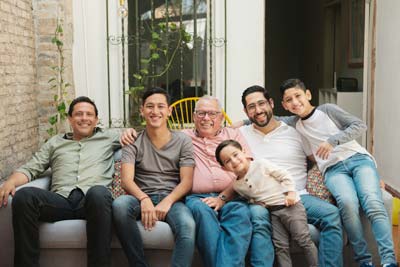 Our brains are amazing, intricate networks that help us think, love, and breathe. But sometimes things go awry and cause brain disorders, such as Alzheimer’s disease and related dementias. By studying the brains of people who have died — both those who had a brain disorder and those who were healthy during life — researchers learn more about how types of dementia affect the brain and how we might better treat and prevent them. Brain donation provides an opportunity to help researchers better understand these disorders, which can lead to improved treatments for future generations.
Our brains are amazing, intricate networks that help us think, love, and breathe. But sometimes things go awry and cause brain disorders, such as Alzheimer’s disease and related dementias. By studying the brains of people who have died — both those who had a brain disorder and those who were healthy during life — researchers learn more about how types of dementia affect the brain and how we might better treat and prevent them. Brain donation provides an opportunity to help researchers better understand these disorders, which can lead to improved treatments for future generations.
While many people think that signing up to be an organ donor includes donating their brain, the purpose and the process of brain donation are different. Rather than helping to keep others alive, such as with kidney donation, brain donation helps advance scientific research. One donated brain can make a huge impact, potentially providing information for hundreds of studies. But many brains are needed from diverse populations and ages to help researchers investigate the causes of disease and to develop more effective therapies that can then be applied broadly.
Why Donate Your Brain?
 People choose to donate their brains after death for various reasons. For some, the primary motivation is to help scientists discover new treatments and preventions for disease. For others, the main goal is to have a positive impact on their community and future generations. Sometimes, family members want to know, for certain, whether their deceased loved one had Alzheimer’s disease or if something else caused the dementia. At present, it is still true that only by examining the brain after death under a microscope is a full diagnosis of Alzheimer’s or another disorder possible. When donating as part of a study that a person actively participated in while alive, or to the NIH NeuroBioBank, there is no cost to the family for the donation procedure or the autopsy report.
People choose to donate their brains after death for various reasons. For some, the primary motivation is to help scientists discover new treatments and preventions for disease. For others, the main goal is to have a positive impact on their community and future generations. Sometimes, family members want to know, for certain, whether their deceased loved one had Alzheimer’s disease or if something else caused the dementia. At present, it is still true that only by examining the brain after death under a microscope is a full diagnosis of Alzheimer’s or another disorder possible. When donating as part of a study that a person actively participated in while alive, or to the NIH NeuroBioBank, there is no cost to the family for the donation procedure or the autopsy report.
One significant benefit of brain donation often catches families by surprise, and that is a sense of solace. Despite losing a loved one, some are comforted by knowing that this action may have a broad, positive impact on public health and wellness in the years ahead.
I did not expect to benefit other than being better informed, but my participation in brain donation can help future generations.
— Study participant at the Rush Alzheimer’s Disease Center
Whatever the reasons, one thing is true for everyone: Brain donation is a generous gift. Researchers use donated brain tissue to study brain diseases that affect millions of people and include Alzheimer’s disease, Lewy body dementia, frontotemporal disorders, mixed dementia, Parkinson’s, and Huntington’s disease, as well as brain injuries such as trauma and stroke.
Researchers learn the most from the brains of people who have participated in studies while they’re still alive. This allows researchers to track changes in memory, thinking, language, and behavior over time and to gather information on environmental and biological factors. The more researchers know about a brain donor, the more they can learn about the relationships among cognitive test results, biomarkers such as blood tests and brain scans, and the changes detected in the donor brain tissue. All of this information helps them gain a better understanding of disease causes, progression, and treatment options. Ultimately, this knowledge will help researchers better target and test treatments in clinical trials.
Who Can Donate Their Brain?
Anyone over age 18 may choose to donate their brain after death. A legal guardian must provide consent for those younger than 18. This includes people who have a brain disorder and those with healthy brains. In fact, both are needed for this important research. Donations from people without symptoms of brain disease provide all-important insights into what’s considered normal aging of the brain and certain brain mechanisms that may protect against disease. Put simply, healthy brains provide researchers with critical models for comparison in understanding what’s gone wrong in cases of disease.
Researchers also need brains from a diverse group of people representing, for example, different races and ethnicities, genders, geographic locations, and sexual orientations.
Potential donors should be aware that brain banks may not be able to accept every brain donation. Given the resources needed to carefully remove, assess, store, and distribute this precious tissue, researchers must prioritize which brains will be most valuable to advancing science. The following are high priority for researchers studying Alzheimer’s disease and related dementias:
- People with healthy brains, including both younger and older people
- Those who are Asian, Black/African American, Hispanic/Latino, Native American and/or Pacific Islander, including both healthy donors and those with dementia
- People diagnosed with non-Alzheimer’s dementias, such as Lewy body dementia and frontotemporal disorders
- People with early-onset Alzheimer’s disease
- Those with Down syndrome, who are at higher risk for Alzheimer’s disease
- People with a diagnosis of dementia who have a family history of dementia
- Participants in clinical trials and other research on Alzheimer’s disease and related dementias
The participation of diverse individuals in research and clinical trials can help researchers understand how dementia affects certain groups and why some communities are disproportionately affected by certain diseases. For example, research suggests that African Americans and Latinos have higher rates of dementia than whites or Asians. Yet, because these groups are underrepresented and understudied in research, there is little information about why this might be and how these diseases affect their communities. Including diverse participants in research helps scientists determine whether there are unique factors that may contribute to dementia and other brain disorders in specific populations.
How to Become a Brain Donor
Although decisions surrounding life and death matters are never easy topics to address, the best time to think about brain donation is now. If you are considering brain donation, talk with your family and friends early in your decision-making process. This may reduce stress and misunderstandings at the time of donation. The opinions of family, friends, spiritual leaders, and others in your community may be helpful as you decide whether donation is right for you.
If you decide to donate your brain, consider enrolling in a study soon to provide the most value to researchers and future generations. NIA-funded Alzheimer’s Disease Research Centers have brain donation programs for their study participants. Contact your nearest center to find out if you’re eligible to participate.
My mother believed in education and service to others. This is an opportunity for others who believe in their community, who believe in research, who have had an interaction with Alzheimer’s to donate. It’s a final gift to those you’re leaving behind, participating in the study, knowing that you can be a part of the solution.
— Keretha, participant in the Wisconsin Brain Donor Program
Another way to become a brain donor is to pre-register with the Brain Donor Project, a partner of the NIH NeuroBioBank. The NeuroBioBank coordinates researcher requests and distributes brain tissue to researchers working to advance the science of brain disease. Pre-registration is strongly recommended because brain recovery must be performed within 24 hours of the time of death. If the appropriate consent and release forms have not been processed in advance, it can jeopardize completion of the process in a timely manner.
What Happens to the Brain During and After Donation?
The brain donation center will coordinate and pay for the body’s transportation to a location, such as a medical facility, mortuary or funeral home, for the brain removal to take place. A specialist will carefully remove the brain through the back of the head in a way that does not affect a person’s appearance. The donor’s body is then returned to the family for funeral arrangements. It is important to restate: Brain donation does not affect the deceased’s appearance, so the family may still have an open casket viewing if they wish.
Once removed, the brain is sent to a brain bank. A specialist at the brain bank will perform an autopsy to determine whether the donor had a type of dementia or another brain disorder. Autopsies are important to understanding how diseases affect the structure and function of the brain and can help direct future research. If requested, the family will receive a summary of these findings, typically within 3 to 9 months. The report often provides some definitive answers to family members. In a person who died without a cognitive disorder, the findings are also summarized, and sometimes there may be disease markers in the brain that didn’t cause symptoms during life. These individuals are of special interest to researchers so they can learn why some individuals did not become ill despite having typical markers of a disease.
The brain is then carefully stored at the brain bank, which will distribute tissue samples to qualified researchers. Researchers must adhere to high standards set by funding organizations such as the NIH as well as their own institutions and gain approval in order to use these precious tissue samples for their investigations. Donor names and other identifiers are not included in information sent to researchers, and all distributed samples are coded to protect the donor and his or her family’s anonymity and privacy. Findings from these future research projects are not shared directly with families. If you are interested in this type of research, you can learn about the latest findings on the NIA website and from PubMed, an online database of journal articles that cover research findings.
Talking to Your Family About Your Decision to Donate Your Brain
 It is important to inform those involved with your end-of-life planning and care about your decision to donate your brain. You may want to include relatives, friends, doctors, and other health professionals to help ensure that everyone involved understands your wishes. Here are some tips:
It is important to inform those involved with your end-of-life planning and care about your decision to donate your brain. You may want to include relatives, friends, doctors, and other health professionals to help ensure that everyone involved understands your wishes. Here are some tips:
- Talk with your family and friends about your plans for brain donation well in advance. Tell them your reasons for donating and share any educational materials you have received.
- Include brain donation wishes in your end-of-life arrangements, such as in medical advance directives and information for your funeral home.
- Make sure your designated family member(s) have the brain bank phone number so they can call within 2 hours after your death.
If your family members have questions, contact your study coordinator or brain donation center contact to help address their concerns.
[My mother] saw the way the disease took her own mother, my grandmother, and when she got the diagnosis herself, she wanted to do the most she could to help science overcome it, so our family, and all other families might be able to avoid Alzheimer’s in the future. For my mother, that meant being a brain donor.
— Kathy Spriggs, daughter of Penn Memory Center brain donor Mary Spriggs
Brain donation is a tremendous gift to the future. It isn’t just about the donor, it’s about that person’s family, their community and the generations to come. Research using donated brain tissue has enabled scientists to answer important questions about many brain diseases, including Alzheimer’s disease and related dementias. However, so much more remains to be understood. If you’re interested in helping to advance the understanding of how these disorders affect the brain and how we might treat and prevent them, consider signing up to donate your brain.
Read about this topic in Spanish. Lea sobre este tema en español.
This content is provided by the National Institute on Aging (NIA), part of the National Institutes of Health. NIA scientists and other experts review this content to ensure that it is accurate, authoritative, and up to date.
Content reviewed: May 22, 2020
